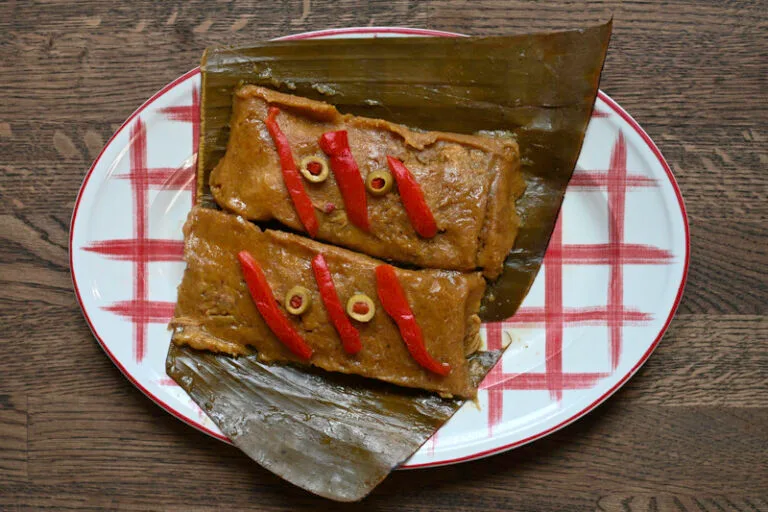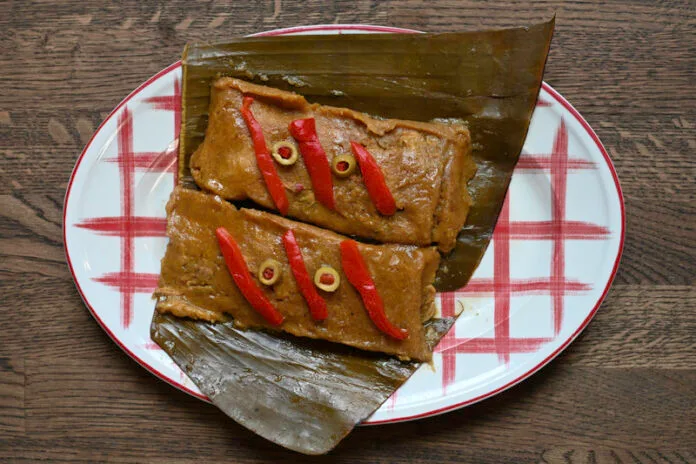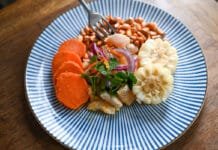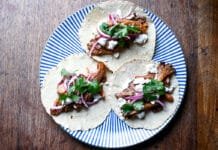This pasteles de masa recipe and blog is brought to you by the National Museum of Puerto Rican Arts and Culture, providing Puerto Rican cultural programming not only at their Chicago museum but also throughout the United States with partnerships and virtual programming.
Making Puerto Rican pasteles de masa is more than just cooking; it taps into family traditions, especially now that we live in Belgium. The aroma of stewed pork, garlic, and adobo filling the house makes the house feel so cozy, even if I’m a thousand miles away from home. As I shared in my video, “When you open them, it is like heaven; all those scents take me back to my childhood in Puerto Rico.” In this blog post, I’ll guide you through my process of making pasteles, sharing tips and stories along the way.
Why Are Pasteles de Masa a Holiday Must-Have in My Family
“A comer pasteles, a comer lechón,” La Fiesta del Pilito by El Gran Combo, is the song that pops into my head as the holiday season approaches and I start to plan my menus. Puerto Rican pasteles de masa, similar to tamales, are made with a root vegetable dough (masa) filled with savory stewed pork and wrapped in fragrant banana leaves. They’re a holiday staple in Puerto Rico, and they hold a special significance in my family. I remember my aunts and mom making them; it always felt like such a special occasion. I fondly look back at my first time helping out as a little girl, carefully tying the pasteles and seeking my Tía Lucy’s approval.
The Ingredients: My Essential Picks for Authentic Flavors
I always emphasize the importance of using fresh, high-quality ingredients to capture the true essence of pasteles de masa. For those like me who live in areas where there are not many Puerto Ricans, look for Southeast Asian, African, and other Caribbean supermarkets to source your ingredients. Here’s what I typically use:
For the Stewed Pork Filling:
- Pork shoulder (bone-in): A bone-in pork shoulder gives the stew the best flavor for your pasteles de masa. We need to get creative in Brussels because they don’t sell whole pork shoulders like in Puerto Rico. I went to the butcher and got pork shoulder thickly sliced, and it was easier to cook than an entire pernil.
- Sofrito: No Puerto Rican kitchen is complete without sofrito! It’s a blend of herbs and vegetables that forms the base of many dishes, and it’s essential for adding depth to the stewed pork.
- Olives (with pimientos): I like to use olives that already have the pimientos inside for extra flavor.
- Adobo & Sazón seasoning: These are my go-to seasoning for almost everything! It adds a savory depth that’s hard to beat.
- Tomato sauce: A good quality tomato sauce adds richness and body to the stew.
- Olive oil: I use olive oil to sauté the sofrito and add richness to the filling.
For the Masa:
- Green bananas: These are the stars of the show when it comes to the masa. They give it that unique starchy texture and slightly sweet flavor. These I find at an African supermarket.
- Root vegetables: I like to use a combination of yautia, calabaza (tropical pumpkin), potatoes, and plantains to add different dimensions of flavor and texture to the masa.
For Assembling the Pasteles:
- Banana leaves: They are key to giving the pasteles de masa their distinct aroma and flavor.
- Parchment paper: This helps prevent the pasteles from sticking and keeps them nice and moist.
- Kitchen string: Essential for tying those little bundles securely.
My Tried-and-True Tips for Pastel Success:
- Softening the pernil before cooking: I always simmer the pork shoulder for about 45 minutes to soften it before I cube it and stew it with the other ingredients. This ensures that the pork is super tender in the final dish.
- Skimming impurities: Remember to skim off any impurities that rise to the top of the broth while the pork is simmering.
- Making the masa: A food processor is your best friend when it comes to grating the vegetables for the masa. And here’s a tip I learned from my sister-in-law, Sylvia, who makes the best pasteles I’ve ever tasted: soak the green bananas in warm water before peeling them – it makes the job so much easier!
- Prepping the banana leaves: I usually pass them over a gas flame to clean and sterilize them. You can try the little workaround I demonstrated in the video if you have an induction range or electric stove.
- Assembling the pasteles de masa: Folding and tying the pasteles can take a bit of practice, but don’t worry, you’ll get the hang of it! I like using parchment paper and banana leaves to ensure everything stays nice and secure.
- Freezing for later: One of my favorite things about pasteles is that you can make a big batch and freeze them later. This is especially helpful during the busy holiday season. Just make sure to freeze them before you cook them.
Do you prefer pasteles de yuca? We got you! Here’s our pastel de yuca recipe.
Print
Puerto Rican Pasteles de Masa: A Step-by-Step Guide
Pasteles de Masa are a traditional Puerto Rican dish made from masa (dough) of green bananas and other root vegetables. They are filled with savory stewed pork and wrapped in banana leaves.
- Total Time: 6 hours
- Yield: 24 Pasteles 1x
Ingredients
For the Masa:
- 2 lbs green bananas
- 1 lb calabaza (tropical pumpkin)
- 2 platanos verdes (green plantains)
- 2 lbs yautia
- 1 large potato
- 1 tbsp achiote oil
- 1 tbsp adobo
- 1 tbsp sazon
- 1 tsp salt
- 1 tsp pepper
- 1 package of banana leaves
Pro Tip: Soaking the green bananas in warm water for a few minutes before peeling makes the process much easier!
For the Meat Filling:
- 4 lbs Pernil (pork shoulder) or a fatty cut of pork
- 1 tbsp of annatto seed oil
- 1/4 cup sofrito
- 1/3 cup tomato sauce
- 1/2 cup pitted olives, Spanish-style
- 1 tbsp of Adobo
- 1 teaspoon of sazón (double if it doesn’t have MSG)
- 2–3 Bay Leaves
- Salt and Pepper to Taste
Instructions
Making Pasteles
Prepare the stewed pork filling:
- Cook the pork in water for around 45 minutes to soften the meat with salt, peppercorns, and bay leaves.
- After cooking for 45 minutes, skim off any impurities that rise to the top of the water, remove the peppercorns and bay leaves, save the broth, and cut the pork into 1-inch cubes.
- In a heavy pot, sauté sofrito and olives in olive oil for 2-3 until fragrant. Note: some people like to add extras like garbanzo beans or red pepper. Make this recipe your own!
- Add the cubed pork (and the bone), adobo, oregano, salt, pepper, and tomato sauce. Add just enough of the reserved broth to skim the top of the ingredients.
- Let it cook for around two hours until the meat is tender. Note: this step can be made a day ahead.
Make the masa:
- Peel green bananas, yautia, pumpkin, potato, and a plantain. Tip: Soak the green bananas in warm water for 10 minutes to make them easier to peel.
- Use a food processor or box grater to grate all the vegetables. I like using the grater attachment first and then running a second run with the blade for a smooth masa.
- Once the masa is ready, add around 1/2 cup of the broth from the pork stew, adobo, salt, pepper, and achiote oil to the grated vegetables.
- Stir until everything is evenly blended. Tip: place the masa in the fridge for at least 4 hours for better texture, preferably overnight.
Prepare the banana leaves:
- Clean the banana leaves on both sides with a wet cloth.
- If you have a gas stove, pass the leaves over the flames to enhancce the flavor and sterilize them. If you have an electric stove, find an alternative method to sterilize the leaves. I like to use a butane torch.
Assemble the pasteles de masa:
- Put a little bit of achiote oil on a banana leaf.
- Add around 1/2 cup of masa to the banana leaf and spread it out.
- Add a generous amount of the stewed pork to the center of the masa, and use a slotted spoon to remove the liquid.
- Add an olive and a piece of tocino from the stew for extra flavor.
- Fold the banana leaf and parchment paper together to form a packet. (How-to in video)
- Tie the packet with kitchen string.
Cook the pasteles
- Freeze the pasteles de masa overnight.
- Boil the pasteles in a large pot of salted water for around an hour.
- Serve hot with arroz con gandules and pernil.
- Prep Time: 3 Hours
- Cook Time: 3 Hours
- Category: Side Dishes
- Cuisine: Puerto Rican
- Diet: Gluten Free











